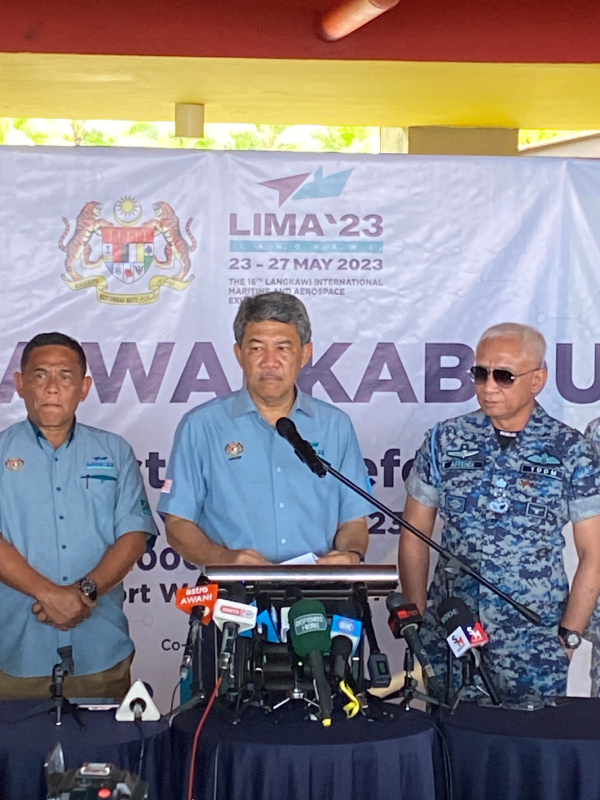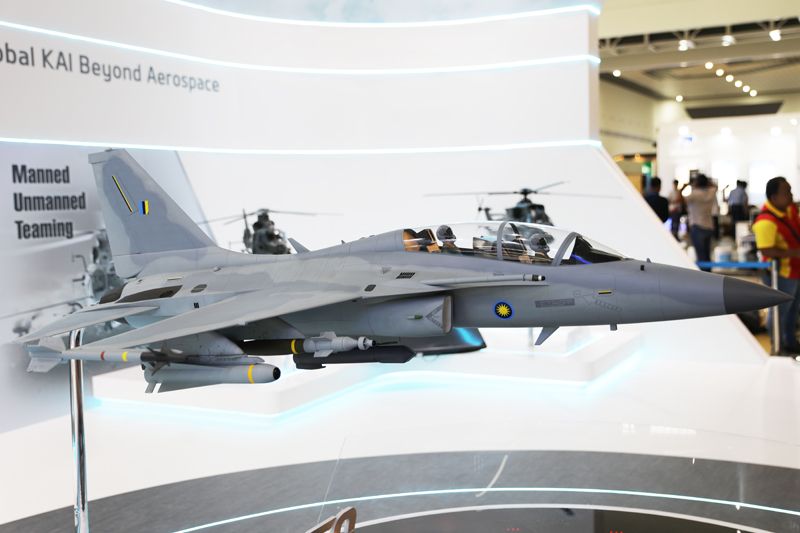LIMA 23 made a welcome return to the international event circuit boasting a heavy naval presence.
Malaysia is one of the nations in the Asia Pacific region that has an established plan to modernise its defence forces. According to the Defence White Paper published in 2020, there are different strands laid down to transform each of the Services and to bring them in line with the envisioned strategic defence interests of Malaysia. These documents are:
- the Army for the Next Generation (Army 4nextG) Strategic Development Plan that envisages thrusts to enhance the Army’s capability towards 2050;
- the RMN 15to5 Transformation Programme, serving as a blueprint to turn the Navy into “a balanced, credible and versatile armada” by 2050;
- the RMAF Capability Development Plan 2055 (CAP55) detailing its modernisation plan up to 2055.
However, as experienced by many countries around the region, plans and affordability do not necessarily align, particularly over several years where national budgets fluctuate with the rise and fall in changing government priorities.
Service chiefs also have a significant influence over how defence budgets are spent, and they are often swayed by their own political leanings and, in some cases, ambitions. Service chiefs around the Asia Pacific region have been guilty of investing in their own Branch of the services, while not considering the requirement for equipment acquisition to contribute into a networked, joint force. A major hinderance to this is the lack of a unifying structure such as NATO, with its Standardisation Agreements (STANAG), which denotes and affirms the agreement of member countries to implement a standard.
LIMA 23
The defence community exhibiting at this year’s 16th Edition of Langkawi International Maritime and Aerospace Exhibition, LIMA 2023. was vibrant. Returning after a four year hiatus due to the COVID pandemic, the focus on maritime capability and and modernisation was in evidence, not only in the exhibition but also in the numbers of visiting naval ships.
This writer asked the Malaysian Defence Minister Datuk Seri Mohamad Hasan, during one of the opening events, how the Malaysian defence forces were working towards the acquisition of joint operating capability across its defence domains. He replied that international exercises, such as those conducted through the Five Power Defence Arrangements (FPDA) – between the UK, Malaysia, Singapore, Australia and New Zealand – were helping his department to identify what was needed and to assist them in prioritising acquisition goals.

Many of the naval exhibitors were targeting the regional intent to build-up national maritime capability and modernise existing fleets, including Malaysia, Indonesia and Thailand.
The Royal Malaysian Navy’s Future Fleet 15 to 5 programme’s aim is to equip the force with Scorpène-class submarines, Maharaja Lela-class frigates, Kedah-class offshore patrol vessels, Keris-class littoral mission ships and the Multi Role Support Ship (MRSS).
Exhibitors keen to be considered this and other potential orders in the region included Italian shipbuilder Fincantieri who was announcing its FCX30 series corvette into the Asian-Pacific region. The FCX30 will be available in three configurations: baseline, multi-purpose and full configuration. It has been built for lean crew operation, although the technology will ultimately be under the control of mission specialists, and to have modularity so that it can be upgraded and modernised when required.
Fincantieri has devised the FCX portfolio of naval ships to cover a multitude of mission tasking. Billed as a new naval strategic asset, there are five ships in the FCX portfolio: the FCX07, FCX15, FCX20, FCX30 and lastly the FCX40. These would be appropriate to deal with all types of threat, matching survivability with great operational flexibility, said a Fincantieri spokesperson. They added that the FCX30 was the top performer in its class with a maximum speed up to 30 knots as well as the silent speed in anti submarine warfare operation. It order to meet each customer’s operational requirements according to the mission profile, three different combat system configuration are proposed.
The FCX series comprises the following: FC07, for fast attack missions (700 tons); FCX15, increased warfare capabilities (1,500 tons); FCX20, extended range operations and high redundancy (2, 300 tons); FCX30, high survivability with anti-ballistic defence (3,200 tons); and lastly FCX40, all warfare domains and reduced manning for type and size (4,300 tons).

One of those berthed alongside where the daily naval display was taking place was the Italian Navy’s Francesco Morosini (P431). The Francesco Morosini is designed for dual-use missions and is equipped with several latest-generation Leonardo systems, including the ATHENA MK2, a new generation two-man naval cockpit, as well as a new electro-optical DSS-IRST (Distributed Static Staring-InfraRed Search and Tracking System), which is designed to help protect the vessel from multiple littoral and Blue Water threats.
Marco Melani, vice president Electronics Marketing and Sales Far East, said that the composition of Leonardo (through a variety of acquisitions over the years) is in a prime position to offer both sensors and weapons systems, managed by a combat management system. “Any customer can rely on one single supplier for a complete combat system,” he said. Commenting on the company’s presence at LIMA, he said that the region “is rich in opportunities” for companies offering products in the maritime sector.
Turkish company STM was keen to display a number of mock-ups of Türkiye’s first national corvette project – the Ada Class MILGEM, Turkiye’s first national frigate the İstif (I) Class Frigate, Pakistan Navy Fleet Tanker, STM-MPAC Multi Purpose Attack Craft, the Coast Guard Ship CG-3100 as well as the STM500, a small-sized submarine.
South Korean shipbuilder Hyundai Heavy Industries (HHI) was aiming at the Malaysian requirement by exhibiting on the stand its HDL-10000 multirole support ship, HDC-2000 Littoral Mission Ship and a Multipurpose Mission Ship.
According to Jin-Woong Choi, senior sales manager, International Defense Program at HHI, the HDC-2000 is based on the 107 metre long HDF-2600 frigate, two of which were built for the Philippine Navy, and commissioned in 2020 and 2021. Data displayed with a scale model listed a length of 92.4m and displacement of around 2,000 tons. With a speed up to 26 knots, the type is aimed directly at the Royal Malaysian Navy’s (RMN) requirement for Littoral Mission Ship Batch 2. The RMN purchased four vessels from China under Batch 1, but when a tender for Batch 2 is released, probably before year’s end, the RMN will be seeking larger and more capable vessels.
The HDL-10000 is a new vessel type for HHI, smaller than Dokdo-class amphibious vessels operated by the Republic of Korea Navy. The HDL-10000 is targeting a Malaysian requirement for three such multirole support ships. The South Korean proposal has two helicopter landing spots on a stern flight deck, a hangar and a well deck that can accommodate up to two landing craft.
As for the Multipurpose Mission Ship, computer-generated imagery showed it in the markings of the Malaysian Maritime Enforcement Agency (MMEA), which acts as the nation’s coast guard.
The vessel carries up to six rigid-hulled inflatable boats – two launched from stern ramps, and two launched from each side of the hull amidships. A flight deck for a helicopter is present, but no hangar, and the design is quite stealthy.
Choi described the Philippines as a “VIP customer” for his company. After constructing two frigates for the Philippine Navy, HHI recently started construction of two corvettes, and it will commence building six Philippine offshore patrol vessels before the end of the year. HHI is also discussing with Thailand its requirement for a second frigate, after Daewoo Shipbuilding & Marine Engineering commissioned a first one in 2019.
Andrew Pulford, Senior Military Advisor at BAE Systems, talked about his company’s continuing commitment to the Royal Malaysian Air Force (RMAF) and to its fleet of Hawk 108/208 aircraft, some of which were delivered in 1990 and have been in service for over 30 years. He said that BAE Systems would continue to support the jets until their replacements were introduced into service. Honeywell is also contributing to the repair of Hawk components as well as supporting the RMAF Lockheed Martin C-130 Hercules aircraft.
The big military aviation announcement was the confirmation of the order to Korea Aerospace Industries (KAI) for a total of 18 FA-50 aircraft for the RMAF. The acquisition is worth a reported $830 million with the FA-50s set to become the RMAF’s lead-in fighter trainers/light combat aircraft.

Staying with the Air Force, other announcements included signed contracts for two Leonardo ATR 72 maritime patrol aircraft (MPA) and three Turkish Aerospace Industries (TAI) Anka-S Medium Altitude-Long Endurance (MALE) unmanned aerial vehicles (UAVs).
At the Resorts World seafront facility, not far from the main exhibition site, a maritime demonstration took place every day with the Malaysian Navy, Air Force helicopters and other ‘blue light’ organisations contributing assets for the main daily display, including an anti-terrorist scenario. Watercraft taking part included an FCB 1326 that completed a number of tight turns and stops, the Royal Malaysian Navy Combat Boat CB90 boat, as well as assorted rigid hull inflatables and assorted high speed craft.

At the same location international naval vessels were tied up alongside to allow official visits and more general visits to take place. Ships on show included the Republic of Korea Navy (ROKN) tank landing ship No Jeok Bong, the previously discussed Italian Offshore Patrol Vessel P431 ITS Francesco Morosini, and the Chinese Peoples Liberation Army Navy (PLAN) CNS Zhanjiang (Type 052D destroyer).
by Andrew Drwiega/Gordon Arthur












